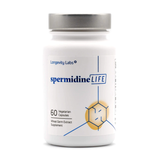
“Out with the old, in with the new”; it’s a phrase we’ve heard our whole lives, whether it’s talking about a new wardrobe, significant other, or even the promise of a brand new year. While this phrase might seem like an idealistic vision looking to the future, there is a lot more science behind it than one might initially think. The biological process of autophagy, from the greek meaning “self-eating”, is a cellular clean up process that has huge ripple effects throughout overall health when either up or down-regulated. The study of autophagy, while it may still be burgeoning onto the headlines of the average american, is one we have understood as being of utmost importance to not only longevity research, but the understanding of our biology as a whole, so much so that there have been two separate nobel prizes awarded to the study behind autophagy.
What is Autophagy?
Autophagy is a “catabolic process” that works to clean up and recycle dead or defective cells within the body (1). It is a multi-tiered system that deals with not only the degradation of select organelles that are either damaged or dead, but also works hard to turn macromolecules within the cytoplasm into biologically-available energy sources used by the cell in times of fasting or caloric restriction. In humans, there are 3 different kinds of autophagy: macroautophagy, the one most commonly referred to as simply autophagy, microautophagy and chaperone-mediated autophagy. Macroautophagy specifically is the “self-eating” of parts of the cytoplasm that have been packaged in autophagosomes, multi-layered vesicles designed to deliver the cytoplasmic package to lysosomes for digestion and repurposing. Additionally, autophagy is an extremely important regulatory factor in organelle homeostasis, and can work to remove senescent organelles and many different “infectious agents” through several pathways and signals (3).
Is it good or bad?
Genetically-induced autophagy, the kind that is constantly working throughout our lives and sees a reduction as we age, helps keep our functioning cells healthy and clears out any damaged or dead cells to keep biological efficiency as high as possible. The reduction in effectiveness of this genetic-triggered autophagy directly results in the buildup of malfunctioning organelles and plays a huge role in the slowing down of our body’s natural renewal systems when we age. Stress-induced autophagy, often triggered by times of fasting, has been purported as an evolutionary adaptation to prevent cellular starvation and “enhances the probability of survival until nutrients become available” (3). As the study into pro-longevity methods continues to grow, one common theme between several of the successful anti-aging techniques is the presence of an upregulation of autophagy, meaning that there are several different pathways in which this cellular process can be beneficial to us in our later years (2). The field of research on humans is limited but growing, so the positive aspects of autophagy are still being discovered on human biology, but there have been several direct links to the down-regulation of autophagic processes and the increase in accelerated aging and age-related diseases, like heart disease, dementia and cancers (3).
How do you induce it?
While autophagy is a natural process that is always occurring within the body, one of the best ways to induce it is through fasting, nutrient deprivation or caloric restriction, with caloric restriction being the “most physiological inducer of autophagy” (1, 4, 3). Other methods of induction include the use of the polyamine Spermidine or the phenol Resveratrol, which induce autophagy through separate and opposite mechanisms (1). Caloric restriction works to trigger autophagy by activating one of two energy sensors, either AMPK or SIRT1. It can also induce autophagy through the “inhibition of insulin/IGF” (3). Spermidine, which occurs naturally in the body, plays several roles in addition to autophagy, including gene expression and apoptosis. It works in a negative feedback loop, inhibiting EP300, an acetyltransferase that, when present, inhibits autophagy. Although comprehensive research on the effects of spermidine and it’s role on autophagic functions in whole-body tissues is yet to be fully explored, it has been shown that “increased dietary spermidine upregulates autophagy, mitophagy and mitochondrial function within the heart”, which is a promising starting point for additional research (2). As far as exogenous inducers of autophagy are concerned, it has yet to be demonstrated, but stands to reason that a diet rich in spermidine or other “pro-autophagic components” would not only help encourage the process of autophagy within the body, but also lead to extended good health (3).
Benefits of Autophagy
Does it help fight cancer?
Autophagy and its role in cancer is a bit of a conundrum; on the one hand, it’s been demonstrated to be an effective tumor suppressor in some cases, but in the other, there has been a link to the unchecked process of cell renewal and the increased incidence of cancer. To say that there is one solid answer to whether autophagy helps or hurts every single kind of cancer would be a foolish, seeing as how every cancer is unique both in it’s own right and to the patient who has it, but there has been an acute search into the use of autophagy and it’s potentially as a treatment for certain cancers. There are certain proteins that are required for the induction of autophagy, like Becilin-1, that also act as “haploinsufficient” tumor suppressors, to both help with tumor suppression but also play a role in the “avoidance of malignant transformations”. Additionally, autophagy can also “suppress oncogenesis through cell-autonomous effects like improved quality control of mitochondria, ameliorated genetic instability and the autophagic removal of potentially oncogenic proteins” (3). This means that yes, autophagy definitely moves the needle when it comes to certain types of cancers, and the presence of autophagy in the cells itself acts as not only a counterweight against the formation of tumors, but can also act as the first line of defense against the growth potentially malignant tumors.
What does it do for your body?
Outside of the already listed benefits autophagy can have within your body, it can help reduce the levels of misfolded proteins, called “proteinopathies”, associated with different neurodegenerative diseases like Parkinson’s, Alzheimer’s and Huntington’s disease. It also helps monitor the quality of mitochondria within cells and clear out any malfunctioning or dying organelles that may be releasing oxidative agents in a process called mitophagy, to better increase cellular efficiency. In addition, autophagy can be used as a valuable means to help reduce unneeded apoptosis and necrosis in post-mitotic cells, meaning that after cells go through mitosis, certain organelles can be either damaged or completely ruined and without a targeted clean-up system this can lead to unnecessary cell death. Autophagy can intervene, targeting the organelles that need to be removed, while leaving the normally functioning organelles and the cell itself unharmed. Furthermore, autophagy has been shown to have positive effects in the preconditioning of the brain and heart to withstand episodes of ischemia, helping to prevent future strokes and infarctions. In the same token, autophagy biology can also help defend against infections by recognizing the foreign matter within the autophagosome and building immunity from there, while also reducing the inflammation that can go along with the immune response (3). Autophagy, specifically mitophagy, is demonstrated as being one of the few effective treatments to battle the loss of muscle tone and function in age, called sarcopenia. This “degenerative loss of skeletal muscle mass and strength” is often the foremost cause of dependence for older adults and the elderly, and is associated with “the accumulation of dysfunctional mitochondria” within the muscle cells. This accumulation prevents the muscle from growing and adapting and eventually leads to the atrophy of the muscle (6).
Can autophagy heal?
While it may not be able to stitch up a flesh wound right before our eyes, there is significant research that shows autophagy’s beneficiality in the cellular healing process. Outside of it’s innate role to clear out damaged organelles, to help create space for the production of new ones, the down-regulation of autophagy triggers both stress-responsive and proinflammatory transcription factors that subsequently result in favorable conditions for inflammation and prolonged tissue injury (3). In the mitochondria, mitophagy plays “an essential role in the recovery of acutely damaged cells that might otherwise undergo apoptosis or necrosis”, saving energy and helping to streamline the body’s efficiency. Autophagy also helps clear out senescent cells, or cells that have stopped dividing (4). Different therapies hoping to target or modulate the methods of autophagy are beginning to become more popular, going after a varied range of diseases, from metabolic conditions to cancer to neurodegenerative diseases and even infections, with pro-autophagic systems potentially helping to reduce “time-dependent deterioration and even provide a transient rejuvenation if applied to the healthy elderly” (4, 3). This means that now, no matter how well someone has aged or how much wear-and-tear they’ve faced, the promise of autophagy therapy could mean a longer healthspan and lifespan, and allow them to make the most of the rest of their life.
Autophagy and Fasting
As explained above, autophagy is a process that can be both genetically-stimulated, as it happens naturally in everyone’s body, or it can be stimulated through stress, often periods of fasting, starvation and caloric restriction.
These stress periods work differently than the periods of genetic stimulation, working to fuel the body using macromolecules stored in the cytoplasm (3, 4). Outside of periods of stress, autophagy is mainly used for maintaining homeostasis, house-keeping of senescent or damaged organelles, and maintaining production of ATP (4).
Listen to this article:







